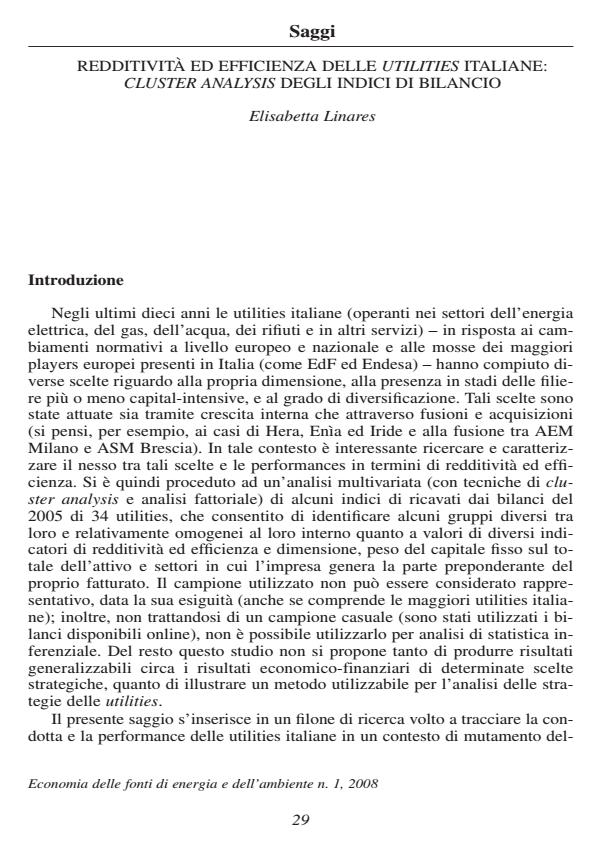Redditività ed efficienza delle utilities italiane: cluster analysis degli indici di bilancio
Titolo Rivista ECONOMIA DELLE FONTI DI ENERGIA E DELL’AMBIENTE
Autori/Curatori Elisabetta Linares
Anno di pubblicazione 2009 Fascicolo 2008/1
Lingua Italiano Numero pagine 28 P. 29-56 Dimensione file 628 KB
DOI 10.3280/EFE2008-001003
Il DOI è il codice a barre della proprietà intellettuale: per saperne di più
clicca qui
Qui sotto puoi vedere in anteprima la prima pagina di questo articolo.
Se questo articolo ti interessa, lo puoi acquistare (e scaricare in formato pdf) seguendo le facili indicazioni per acquistare il download credit. Acquista Download Credits per scaricare questo Articolo in formato PDF

FrancoAngeli è membro della Publishers International Linking Association, Inc (PILA)associazione indipendente e non profit per facilitare (attraverso i servizi tecnologici implementati da CrossRef.org) l’accesso degli studiosi ai contenuti digitali nelle pubblicazioni professionali e scientifiche
Profitability and efficiency of Italian utilities: cluster analysis of financial statement ratios - The last ten years have witnessed conspicuous changes in European and Italian regulation of public utility services and in the strategies of the major players in these fields. In response to these changes Italian utilities have made a variety of choices regarding size, presence in more or less capital-intensive stages of different value chains, and diversification. These choices have been implemented both through internal growth and by means of mergers and acquisitions. In this context it is interesting to try to establish whether there is a nexus between these choices and the performance of Italian utilities in terms of profitability and efficiency. Therefore statistical multivariate analysis techniques (cluster analysis and factor analysis) have been applied to several ratios obtained from the 2005 financial statement of 34 utilities. First, a hierarchical cluster analysis method has been applied to financial statement data in order to identify homogeneous groups based on several indicators of the incidence of costs (external costs, personnel costs, depreciation and amortization), profitability (return on sales, return on assets, return on equity) and efficiency (in the utilization of personnel, of total assets, of property, plant and equipment). Five clusters have been found. Then the clusters have been characterized in terms of the aforementioned indicators, the presence in different stages of the energy value chains (electricity and gas) and other descriptive variables (such as turnover, number of employees, assets, percentage of property, plant and equipment on total assets, sales revenues from electricity, gas, water supply and sanitation, waste collection and treatment and other services). In a second round cluster analysis has been preceded by factor analysis, in order to find a smaller set of variables. This procedure has revealed three not directly observable factors that can be interpreted as follows: i) efficiency in ordinary and financial management, ii) return on invested capital and return on equity capital, and iii) efficiency of personnel. Cluster analysis has identified four clusters. Each cluster has then been described in terms of the factors, the profitability and the efficiency indicators (Return on Sales, Return on Equity, Return on Assets, Turnover / Personnel Costs, Capital Intensity), the presence in different stages of the energy value chains and the same descriptive variables used for the previous set of clusters. Based on indicators of cost incidence, profitability and efficiency, five cluster have emerged. Based on three non-observable factors (efficiency in ordinary and financial management, return on invested capital and on equity capital, efficiency of personnel) four clusters have emerged. These results suggest that there may be a nexus between the performances of the observed Italian utilities and some of their characteristics, such as size (in terms of total assets), presence in more or less capital-intensive stages of the value chains of different public utility services, and the industries in which these enterprises generate most of their sales revenues (i.e. their core businesses) or, in other words, the extent of diversification. This hints to a couple of avenues for future research, such as the replication of this kind of analysis on a larger sample, with the same or different indicators, and the identification of economies of scale, economies of density, economies of scope and industry-specific factors that may help to explain the results of multivariate statistical analysis of financial statement data. JEL: L940, L950 Key words: utilities, energy, strategy, cluster analysis, factor.
Elisabetta Linares, Redditività ed efficienza delle utilities italiane: cluster analysis degli indici di bilancio in "ECONOMIA DELLE FONTI DI ENERGIA E DELL’AMBIENTE" 1/2008, pp 29-56, DOI: 10.3280/EFE2008-001003